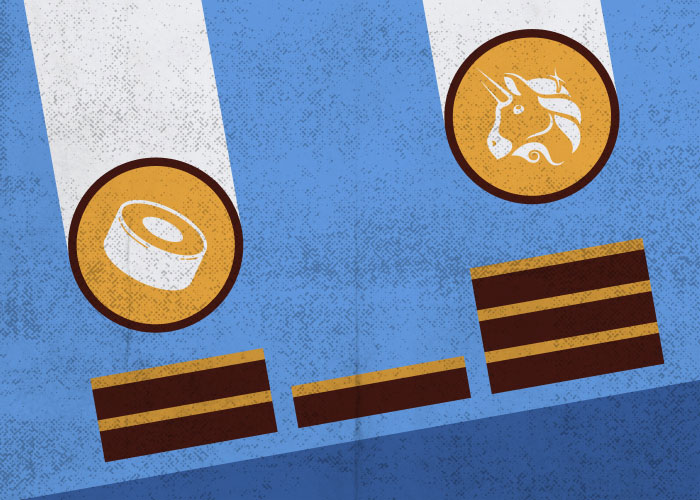DeFi Staking

DeFi projects are banking systems based on distributed ledger technology (DLT). Decentralized lending protocols and innovative DeFi investment platforms raise more and more money every year in their apps. According to the DefiLlama service, as of July 12, 2022, the total value locked (TVL) in DeFi protocols is about $73.3 billion.
Let’s figure out how to get passive income through DeFi projects and what are the advantages and disadvantages of delegating funds to staking in this way.
DeFi Staking Features

Passive income within this context involves delegating assets to liquidity pools of DeFi projects.
The DeFi infrastructure is managed by smart contracts that automatically allocate funds. The security of invested assets will depend on their reliability.
There are two types of digital asset delegation in DeFi staking:
- Liquidity mining or so-called yield farming. This type of DeFi staking involves providing crypto-assets to ensure liquidity to DeFi protocols in return for their tokens or a percentage of the delegated funds. The profitability of liquidity mining can be calculated at a fixed or floating rate and will directly depend on the number of locked funds.
- Crypto lending. This involves lending cryptocurrency at interest or as collateral against other digital assets.
The distinctive feature of DeFi staking is its dependence on smart contracts, ensuring the functioning of DeFi protocols. Whereas staking through cryptocurrency wallets or staking on cryptocurrency exchanges involves paying fees for freezing assets to keep crypto protocols functioning, income from DeFi staking refers to interest payments for the transfer of funds to third parties for use.
Pros & Cons of DeFi Staking

DeFi staking has a number of obvious advantages:
- Specifics of profit accrual. Remuneration in yield farming is credited to the account daily, so the investor can partially level the impact of market fluctuations on the profitability of DeFi staking by promptly managing their portfolio.
- No special equipment is needed. Yield farming doesn’t require the creation of a validator node to implement staking, so there is no need for computing power to maintain it.
- Full automation. Income from DeFi staking is accrued automatically due to smart contracts, the mechanisms of which redistribute rewards without the need to request them manually.
- The number of DeFi protocols. The sector’s growth has led to an increase in the number of platforms available for staking, resulting in a more competitive environment and greater benefits for their users.
DeFi staking disadvantages include:
- Security. The vulnerability of DeFi protocols at the smart contract level can lead to partial or complete loss of assets sent to staking.
- High fees. The popularity of DeFi projects has led to an increased load on the Ethereum blockchain on which most of them operate. Transaction fees have risen significantly, reducing the profitability of DeFi staking and the return on investment.
- Scam probability. New DeFi protocols offering high annual returns are very likely to be fraudulent.
- Market volatility. Fluctuations in the value of crypto-assets affect DeFi staking returns. Daily remuneration partially levels out the effect of fluctuations, but the overall risk remains.
DeFi Staking Through Crypto Exchanges

Some major cryptocurrency exchanges provide users with access to their own DeFi staking services to secure the liquidity of various projects.
Curve Finance
The decentralized exchange allows for passive income by providing liquidity in pools between various stablecoins. This exchange uses the so-called bonding curve to regulate the connection between supply and demand for tokens. Generally speaking, the bonding curve ensures a coin’s liquidity when it’s as close as possible to the price of its backing asset.
Rewards for yield farming via Curve Finance are paid in native Curve DAO Tokens (CRV). The CRV coin is also a governance token, granting voting rights to the decentralized autonomous organization that manages the Curve protocol.
The most popular liquidity mining pools on Curve Finance are:
- Providing liquidity for wrapped Bitcoin tokens. The renBTC-wBTC pair will bring about 1.76% annual returns, the hBTC-wBTC pair APY is 6.83%, and the renBTC-wBTC-sBTC trio generates 2.11% annual returns.
- Liquidity farming of wrapped Ethereum tokens. The ETH-stETH pair will generate a 3.71% annual return, the APY of the ETH-sETH pair is 6.69%, and the ETH-ankrETH pool has a 2.42% annual return.
- Securing stablecoin liquidity. The DAI-USDC pair brings 11.33% per annum, the DAI-USDC-USDT-sUSD pool yield is 14.67% per annum, and the DAI-USDC-USDT-BUSD pool APY is 7.25%.
Besides stablecoins and wrapped tokens, Curve Finance provides rewards for liquidity farming of some cryptocurrency pairs. The most profitable pool on the platform is the Silo-FRAX pair, with an APY of 6.91%.
SushiSwap
The cryptocurrency exchange allows DeFi staking and the possibility to earn native tokens of the SUSHI platform, providing liquidity to its pools.
The most profitable pools for DeFi staking on SushiSwap are:
- YFI Whale. A pool for providing liquidity to the YFI and ETH token pair with an APY of 17.73%.
- Tether Turtle. The USDT and ETH pair pool has an APY of 11.71%.
- Spartan Dollar. Providing liquidity to the SUSD and ETH pair will bring the investor 4.46% per annum.
It’s worth noting that the native token SUSHI can be used to provide liquidity and be rewarded for its staking. For example, the Sushi Party! pool can provide the SUSHI-ETH pair liquidity with an APY of 4.24%, and SUSHI tokens deposited via SushiBar will bring returns of 13.06% per annum, or 14.71% when coins are locked for six months. Interestingly, SUSHI staking rewards will accrue on another platform token, xSUSHI.
DeFi Staking Platforms

Several specialized protocols for DeFi staking provide the opportunity to earn income for depositing funds. Let’s take a look at some of them.
Compound
DeFi staking allows you to lend and borrow in digital assets. The interest rate on rewards on Compound is generated according to the supply and demand for a particular asset, so it’s floating. Smart contracts manage the entire process.
The platform automatically transfers tokens delegated to its accounts into cTokens. Wrapped tokens with the add-on c- are used to return deposits and are essentially synthetic assets.
DeFi staking income on Compound is accrued in native tokens from the COMP platform. The minimum amount for withdrawing rewards is 0.001 COMP.
Compound investors can earn income on Borrow Markets. This involves delegating assets to third parties for use. The service acts as a return-on-investment guarantor. AAVE has the highest interest rate at 11.48% per annum. Deposits in native tokens from popular exchanges SUSHI and UNI yield 5.2% and 5.48% per year, respectively. Deposits in ETH and DAI, whose APYs are only 2.64% and 2.89%, are less profitable.
Keep in mind that all transactions on the platform are subject to fees, the amount of which should be considered before sending assets, otherwise staking may be unprofitable or even lead to losses.
ClayStack
The ClayStack protocol enables the use of synthetic assets based on coins locked in PoS staking. Once tokens are deposited into ClayStack smart contracts, investors receive wrapped ERC-20 tokens with the add-on cs- in the name. These derivatives remain fully fungible in the original blockchain network.
The platform offers staking via the Victoria testnet or directly through the ClayStack app. To delegate funds, you must:
- Connect a cryptocurrency wallet. Access is available through a Coinbase account or MetaMask, Ledger, Tokenary, Infinity Wallet, Wallet 3, SecuX, Ambire, RICE Wallet, KEYRING PRO, PunkWallet, and KryptoGO wallets.
- Choose the desired asset for staking from one of the seven available networks in the Mission Hub menu.
- Exchange the number of original tokens to cs-tokens at the rate indicated in the app. You will need to add cs-tokens to the wallet linked to the service and confirm the operation.
Staking and reward accruals will start automatically as soon as cs-tokens are added to the wallet. Investors don’t need to delegate derivatives received or worry about the node’s performance — ClayStack algorithms will take care of that.
The platform charges a fee for exchanging coins to cs-tokens, but there are no other hidden fees in the app. It’s up to the investor to decide how to use the received cs-tokens — eventually, exchange them for original or other liquidity tokens or sell them via the exchange.
The assets can also be withdrawn from staking through the Mission Hub menu by choosing the necessary amount of cs-tokens and exchanging them back to the original coins at the rate specified in the app. Notably, the withdrawal of assets from staking is carried out instantly — they will be available in your wallet in just a few seconds.
The main assets for liquidity staking via ClayStack are:
- Polygon (MATIC). The expected APY of csMATIC on Ethereum and Polygon networks is around 10.49%. On Goerli or Mumbai testnets, the annual return is 118.96%.
- Graph (GRT). The expected return on csGRT in Rinkeby is 2.27% per year.
- Ethereum 2.0 (ETH2). Staking is available on Goerli and Rinkeby, with a minimum deposit amount of 0.2 ETH. The return on the asset is floating.
Like any investment niche, DeFi staking isn’t an easy way to earn money and requires regular monitoring of the market situation and understanding of the market conjuncture. The choice of a DeFi staking platform can depend not only on its profitability but also on the safety of the assets. Read more about how to avoid cryptocurrency fraud in the op-ed.











